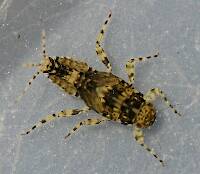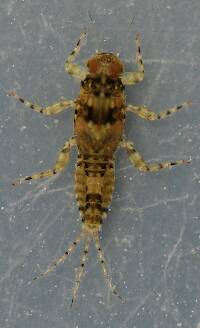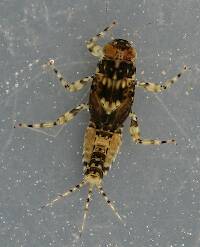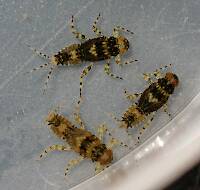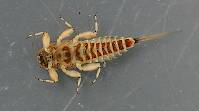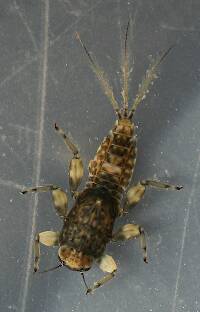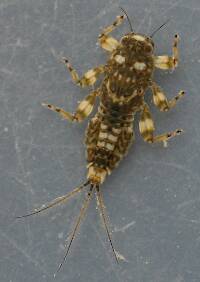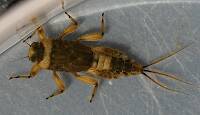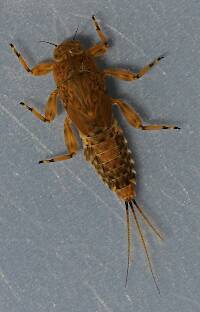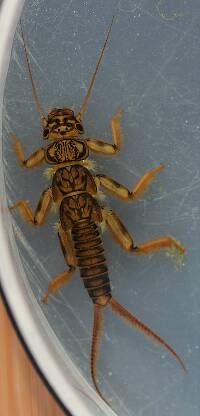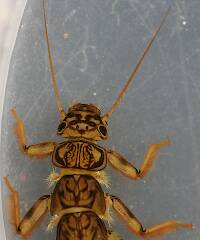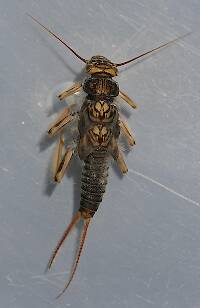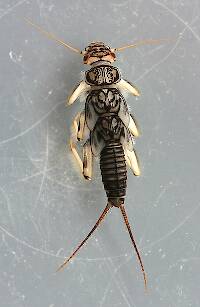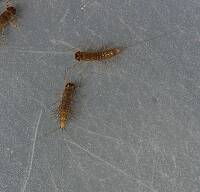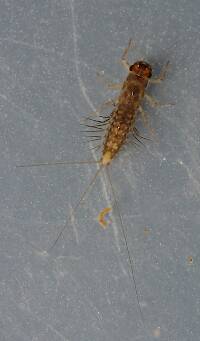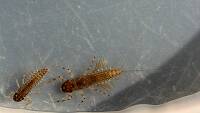
Salmonflies
Pteronarcys californica
The giant Salmonflies of the Western mountains are legendary for their proclivity to elicit consistent dry-fly action and ferocious strikes.
Featured on the forum

With a bit of help from the microscope, this specimen keys clearly and unsurprisingly to Hydropsyche.

Troutnut is a project started in 2003 by salmonid ecologist Jason "Troutnut" Neuswanger to help anglers and
fly tyers unabashedly embrace the entomological side of the sport. Learn more about Troutnut or
support the project for an enhanced experience here.

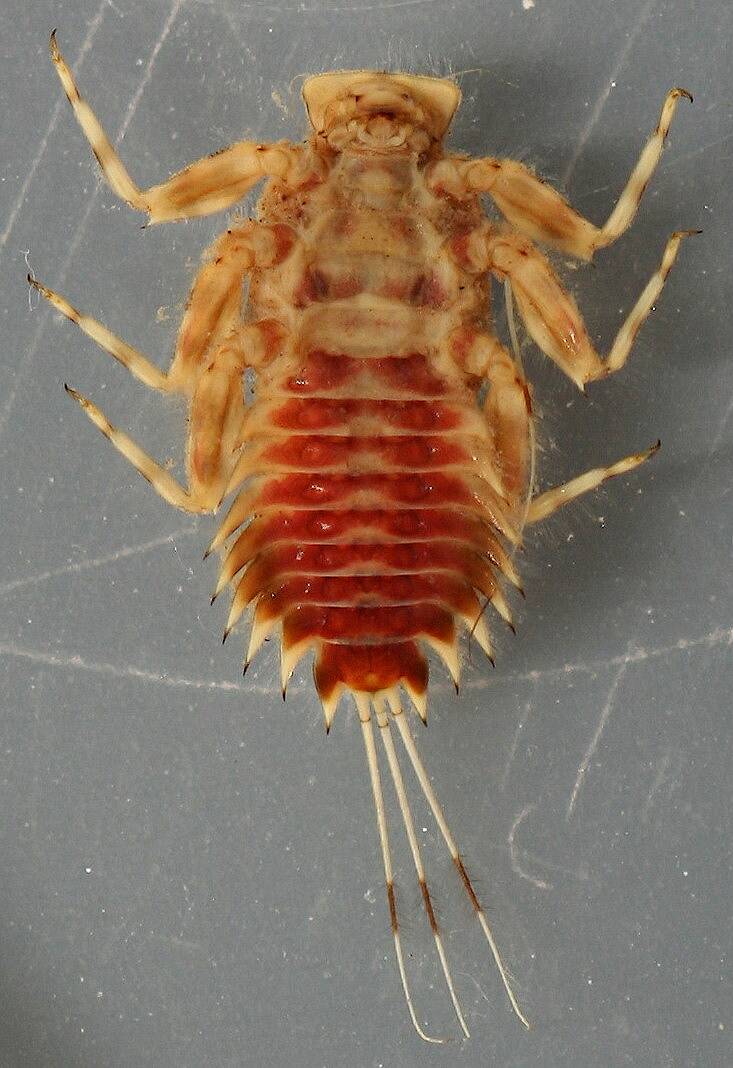
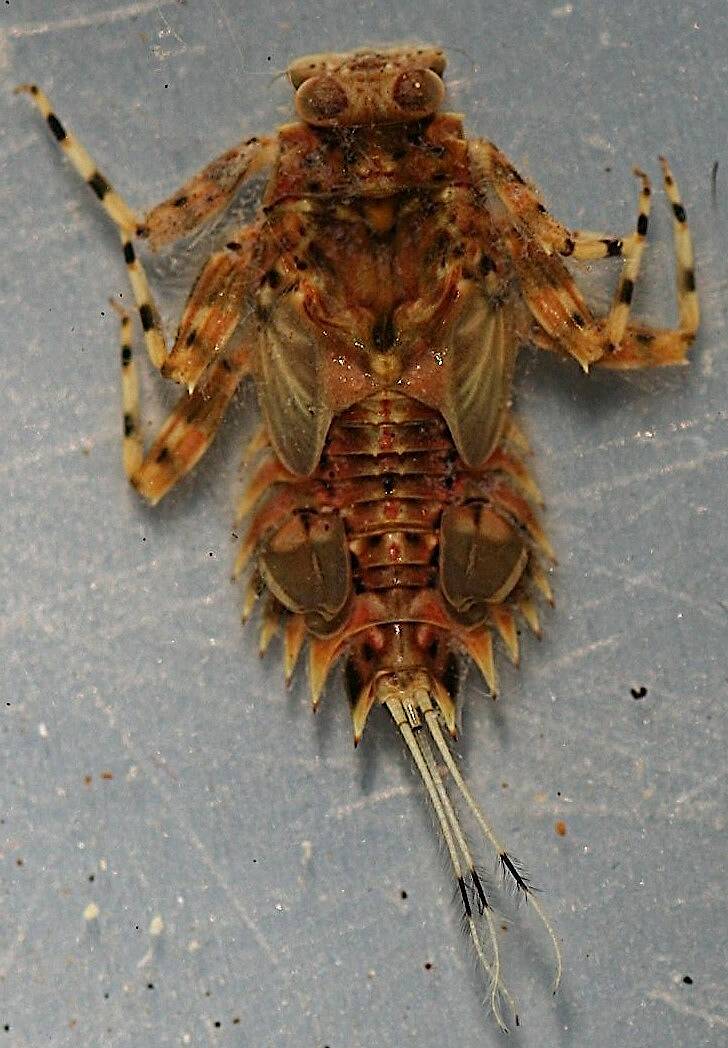
Millcreek on Sep 17, 2014September 17th, 2014, 10:56 am EDT
IDed these nymphs to genus using Merritt, Cummins and Berg (2008). The genus is monotypic. The only species in the genus is Timpanoga hecuba which is divided into two subspecies, Timpanoga hecuba hecuba and Timpanoga hecuba pacifica. Personally, I think it should just be a single species. The nymphs of the two subspecies as described by Allen and Edmunds are separated by either having spines on the posterior edges of the abdominal tergites (Timpanoga hecuba pacifica) or not (Timpanoga hecuba hecuba). Collections I've gotten from Mill Creek (tributary of the Russian River) have the spines on about half the specimens while the others are entirely without. So far as I know only Timpanoga hecuba pacifica has had the adults described.
The paper by Allen and Edmunds describing Timpanoga hecuba and its division into the two subspecies is "A Revision of the Genus Ephemerella (Ephemeroptera: Ephemerellidae). I. The Subgenus Timpanoga" and can be found here: http://www.ephemeroptera-galactica.com/pubs/pub_a/puballenr1959p51.pdf
The nymphs are most common from mid-summer through late fall and are found in slack water at the edges of pools or glides. They often have a coating of silt on them.
The paper by Allen and Edmunds describing Timpanoga hecuba and its division into the two subspecies is "A Revision of the Genus Ephemerella (Ephemeroptera: Ephemerellidae). I. The Subgenus Timpanoga" and can be found here: http://www.ephemeroptera-galactica.com/pubs/pub_a/puballenr1959p51.pdf
The nymphs are most common from mid-summer through late fall and are found in slack water at the edges of pools or glides. They often have a coating of silt on them.
"If we knew what it was we were doing, it would not be called research, would it?"
-Albert Einstein
-Albert Einstein
Millcreek on Sep 17, 2014September 17th, 2014, 7:49 pm EDT
Roger-
I found it both interesting and entertaining. Especially liked the first elimination of a species by you and Kurt.
But I still don't think the subspecies are justified given the rather tenuous and variable distinction of spines versus no spines on the abdominal tergites. By that criteria the ones I've collected in a 100 yard stretch of Mill Creek are about equally divided between the two subspecies, some having spines and some without.
I found it both interesting and entertaining. Especially liked the first elimination of a species by you and Kurt.
If larger than an inch - Horseshoe Crab :)
But I still don't think the subspecies are justified given the rather tenuous and variable distinction of spines versus no spines on the abdominal tergites. By that criteria the ones I've collected in a 100 yard stretch of Mill Creek are about equally divided between the two subspecies, some having spines and some without.
"If we knew what it was we were doing, it would not be called research, would it?"
-Albert Einstein
-Albert Einstein
Jmd123 on Sep 17, 2014September 17th, 2014, 7:56 pm EDT
WOW Mark, those are cool-looking creatures! And I must add that your photography is superb. You have definitely been a fine addition to this website and I know the "hard-core bug guys" feel the same. Thanks for your contributions!
Jonathon
Jonathon
No matter how big the one you just caught is, there's always a bigger one out there somewhere...
Millcreek on Sep 18, 2014September 18th, 2014, 6:43 am EDT
Jonathan-
Thanks, I've enjoyed posting to this site. I get to show off some of the local bugs and as a bonus get advice on identification and habits of some of them.
As far as photography is concerned it's certainly gotten easier with digital cameras. No more film to buy, no more developing costs and with the PHD (Push Here Dummy) features all you have to do is take enough pics and a few are bound to be good.
Yeah, a little more size to them and they could star in "Timpanoga vs Godzilla".
By the way, nice fish in your last post.
Thanks, I've enjoyed posting to this site. I get to show off some of the local bugs and as a bonus get advice on identification and habits of some of them.
As far as photography is concerned it's certainly gotten easier with digital cameras. No more film to buy, no more developing costs and with the PHD (Push Here Dummy) features all you have to do is take enough pics and a few are bound to be good.
WOW Mark, those are cool-looking creatures!
Yeah, a little more size to them and they could star in "Timpanoga vs Godzilla".
By the way, nice fish in your last post.
"If we knew what it was we were doing, it would not be called research, would it?"
-Albert Einstein
-Albert Einstein
Oldredbarn on Sep 18, 2014September 18th, 2014, 6:50 am EDT
What was mother nature up to with this one?! Wow! It looks as if it has been pressed in a book. And that crab-like abdomen...
Spence
Spence
"Even when my best efforts fail it's a satisfying challenge, and that, after all, is the essence of fly fishing." -Chauncy Lively
"Envy not the man who lives beside the river, but the man the river flows through." Joseph T Heywood
"Envy not the man who lives beside the river, but the man the river flows through." Joseph T Heywood
Millcreek on Sep 18, 2014September 18th, 2014, 4:44 pm EDT
What was mother nature up to with this one?! Wow! It looks as if it has been pressed in a book.
I'm not sure what mother nature or evolution were up to flattening it out like that but I suspect since the nymphs sit out in the open on flat silty areas that a low profile makes them a little less noticeable to sculpins as well as predatory stonefly and dragonfly larvae. In addition they quite often have a lot of debris that gets caught on those hairy little bodies. A good example can be seen here: http://bugguide.net/node/view/74565
"If we knew what it was we were doing, it would not be called research, would it?"
-Albert Einstein
-Albert Einstein
Jmd123 on Sep 18, 2014September 18th, 2014, 11:18 pm EDT
"Yeah, a little more size to them and they could star in "Timpanoga vs Godzilla"."
Had to LOL a few times on that remark, still doing so!!
You know, I immediately thought of a clinger nymph in the family Heptageniidae, all flattened out so it could hold onto a rock in mid-riffle waters, eyes on top of the head, etc. But slow silty waters?? What family is this bug in? With those operculate gill covers?
Jonathon
Had to LOL a few times on that remark, still doing so!!
You know, I immediately thought of a clinger nymph in the family Heptageniidae, all flattened out so it could hold onto a rock in mid-riffle waters, eyes on top of the head, etc. But slow silty waters?? What family is this bug in? With those operculate gill covers?
Jonathon
No matter how big the one you just caught is, there's always a bigger one out there somewhere...
Millcreek on Sep 19, 2014September 19th, 2014, 5:06 am EDT
What family is this bug in? With those operculate gill covers?
It's a member of Ephemerellidae. There's another member of Ephemerellidae in this area with operculate gill covers, Eurylophella lodi.
The nymphs of Eurylophella lodi prefer faster waters with a clean bottom. A couple photos can be seen here:http://bugguide.net/node/view/879110
"If we knew what it was we were doing, it would not be called research, would it?"
-Albert Einstein
-Albert Einstein
Feathers5
Posts: 287
Posts: 287
Feathers5 on Sep 19, 2014September 19th, 2014, 5:25 am EDT
Okay, what kind of bug is it? It doesn't look like the bug in the link you provided. Your photos seem to indicate a short, squat bug body. The one in the link is long and skinny. Is it a sulfur?
Millcreek on Sep 19, 2014September 19th, 2014, 5:33 am EDT
It doesn't look like the bug in the link you provided. Your photos seem to indicate a short, squat bug body. The one in the link is long and skinny.
They're different in appearance and different species, but members of the same family. I was just trying to show that the gill structure was similar. It's unusual for Ephemerellidae.
Is it a sulfur?
No, but given it's evil appearance it may come from a place with a sulfurous aroma.:)
"If we knew what it was we were doing, it would not be called research, would it?"
-Albert Einstein
-Albert Einstein
Quick Reply
Related Discussions
Topic
Replies
Last Reply
1
Jan 29, 2016
by Martinlf
by Martinlf
0
Jul 19, 2019
by Millcreek
by Millcreek
9
Apr 14, 2015
by MiltRPowell
by MiltRPowell
2
Nov 28, 2012
by Brookyman
by Brookyman





